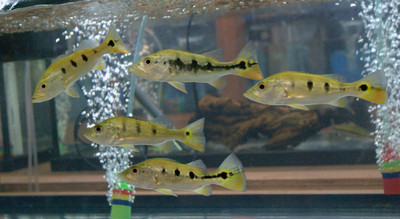Mono Peacock Bass: The Magnificent Predator of South American Waters
Posted by Max Gandara on on 2nd Apr 2024
Appearance and Identification
The Mono Peacock Bass is instantly recognizable by its sleek, torpedo-shaped body, formidable jaws, and striking coloration. It features a base coloration ranging from olive green to golden yellow, adorned with bold black stripes or bars that extend horizontally along its flanks. These distinctive markings serve as camouflage in its natural habitat, helping the fish to ambush prey with stealth and precision.
One of the most striking features of the Mono Peacock Bass is its vibrant iridescent scales, which shimmer and reflect light in shades of blue, green, and gold. These iridescent colors intensify during moments of aggression or excitement, adding to the fish's overall allure and beauty.
Adult Mono Peacock Bass can reach impressive lengths of up to 24 to 30 inches (60 to 75 centimeters) and weights exceeding 10 pounds (4.5 kilograms), making them formidable predators in their aquatic ecosystems.
Natural Habitat
Native to the freshwater rivers, lakes, and tributaries of South America, particularly in the Amazon basin and surrounding regions, the Mono Peacock Bass inhabits warm, tropical waters with abundant vegetation and ample prey. It can be found in various aquatic environments, including slow-moving rivers, oxbow lakes, flooded forests, and backwater lagoons.
In its natural habitat, the Mono Peacock Bass is an apex predator, preying on a variety of smaller fish, crustaceans, and even small mammals or birds that venture too close to the water's edge. Its aggressive hunting tactics and voracious appetite make it a formidable predator and a prized catch for anglers seeking a thrilling challenge.
Aquarium Care
Keeping Mono Peacock Bass in captivity requires careful consideration of their size, temperament, and dietary needs. Here are some essential care guidelines:
- Tank Size: Provide a spacious aquarium with ample swimming space and hiding places. Due to their large size and predatory nature, Mono Peacock Bass require a minimum tank size of 200 gallons for a single adult specimen, with larger tanks preferred for multiple individuals or community setups.
- Water Parameters: Maintain stable water conditions with temperatures between 75°F to 85°F (24°C to 29°C), pH levels around 6.0 to 7.5, and moderate hardness. High-quality filtration and regular water changes are essential for maintaining water quality and oxygenation.
- Substrate and Decor: Use a fine substrate such as sand or smooth gravel to mimic the natural habitat of the Mono Peacock Bass. Decorate the aquarium with driftwood, rocks, and live or artificial plants to create hiding places and break up sightlines. Avoid sharp decorations or abrasive substrates that could injure the fish.
- Diet: Mono Peacock Bass are carnivorous predators that require a diet rich in protein. Offer a variety of live or frozen foods such as feeder fish, shrimp, crayfish, and earthworms, supplemented with high-quality pellets or carnivore-specific commercial foods. Feed them appropriately sized portions two to three times a week, adjusting the frequency based on their appetite and growth.
- Compatibility: Due to their aggressive and predatory nature, Mono Peacock Bass are best kept with larger, similarly sized fish species or as solitary specimens. Avoid housing them with smaller or more timid species that may become targets of aggression or predation.
Breeding Behavior
Breeding Mono Peacock Bass in captivity is challenging and rarely accomplished outside of specialized breeding facilities. In their natural habitat, Mono Peacock Bass exhibit complex courtship rituals, with males establishing territories and engaging in elaborate displays to attract females.
Once spawning occurs, the female will deposit her eggs on submerged vegetation or rocky substrates, where the male will fertilize them. The parents will guard the eggs and fry fiercely, aggressively defending their territory against potential threats.
Conclusion
In the dynamic world of freshwater aquaria, the Mono Peacock Bass stands as a symbol of strength, beauty, and predatory prowess. With its imposing size, aggressive nature, and stunning coloration, this species continues to captivate and inspire anglers and aquarists seeking a thrilling challenge. By providing proper care, attention, and appreciation for these magnificent predators, enthusiasts can experience the raw power and beauty of the Mono Peacock Bass in their own aquatic realms.

